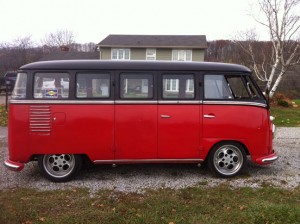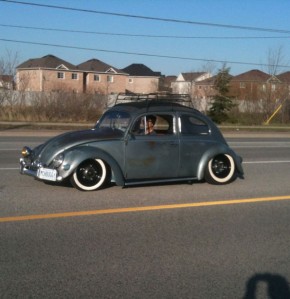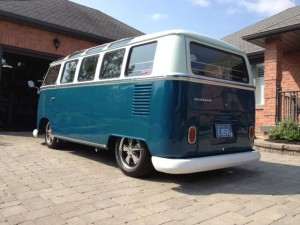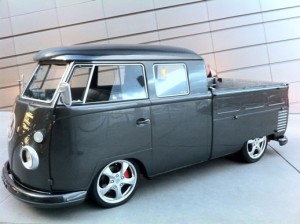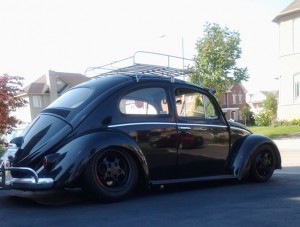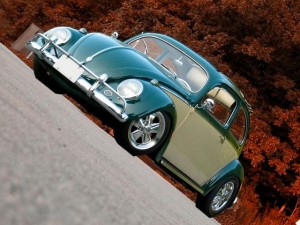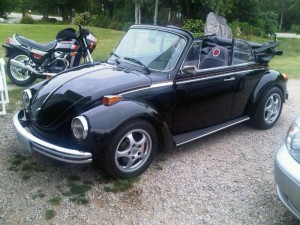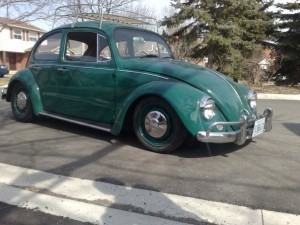
Archive for the ‘Technical’ Category
|Porsche Brake Conversions
Monday, February 13th, 2012
Porsche Brake Conversions
Update: May 2011
I get a lot of questions everyday regarding 944 brake conversions. I figured I’d put together an outline that covers the fitment of Porsche 944 brakes onto your T1’s. This is by no means the final word, there is tons of info on the web. Your best bet is www.germanlook.net. I’ll add pics as I get a chance. I use many of short forms (because I’m lazy), so this may help you understand:
1302- Super beetle, straight windshield, 3-bolt struts
1303 – Super beetle, curved windshield, 2-bolt struts
BJ- Ball Joint, 66+ T1’s
IRS- Independent rear suspension, in reference to 69+ T1’s (North America).
LP- Link pin, reference to front suspension 65- T1’s.
KG- Karmann Ghia
MC – Master cylinder
NA- Normally aspirated
T1 – Type 1, reference to beetle 1200, 1300, 1500, 1600, 1302, 1303.
T2- Type 2, Bus.
T- Turbo
If you are fed up of seeing the same KG front disk and stock rear drum on your dub, then the 944 brake systems may be the solution. So how do you get the brakes on your car?
Rear: We’ll start here since it’s the easiest. There are basically three varieties of 944 rear brake setups.
1) Early NA (83-85).
The caliper is sliding steel (ATE) axial mount with a ventilated disk (290mmx20.4mm).Early NA’s had steel IRS arms which are exactly the same as IRS T1’s. Some people claim that the 944 arms are internally reinforced whereas the T1’s are not. I’ve never had the nerve to chop one up to find out. You can put the whole arm on your T1, but you will have to replace the 944 pivot bushing with a suitable T1 one. I personally think the 944 arm is the same as T1, so I see no point to putting on the whole arm. If you want the 944 rear brakes, you will need the 944 backing plate (BP). The 944 BP bolts onto the T1 IRS arms in the same position as the T1 drum BP’s. The 944 BP’s have caliper-mounting ears incorporated into them. You will also need the 944 hubs, disks, calipers, brake shoes (for ebrake) and hardware. You can also install the 944 spring plates (although not required, as the T1 spring plates will also work) as they allow some adjustability of camber/height ( camber/toe adjustability only works with 944 arm because they have an additional hole machined that T1 arms are lacking). You can use the 944 stub axle if you wish, since if afford the use of the larger 100mm joints (as opposed to 90mm T1 joints). To make use of the complete 944 axle assembly (axle shaft and 2-100mm joints), you will need type 181 (thing) transmission output stubs on your T1 transmission since they allow the use of the 100mm joint. You can also machine the shoulder on one side of a T1 axle is you want to use the 100mm joint at the wheel side but a 90mm on the transmission side (100mm joint is wider than 90mm). If you have a 901 transmission, then use the 911 output stubs (100mm) and you can bolt the whole 944 axle assembly in place. There is a small issue of interfacing the T1 e-brake cable to the 944 e-brake hardware. See products for the required pieces. The stock early 944 setup comes with spacers and long studs. With spacers the offset increase is 43.5mm per side. The spacers can be removed and shorter studs installed (studs from 86+rear or 83-85 fronts). The spacers are 21mm so without them this nets 22.5mm offset increase per side. There you go, 944 rear disks!
2) Early turbo’s ( 85.5? and 86) have cast aluminum arms.
These arms can be differentiated from the later arms by having a bump-stop location cast into the arm. The caliper is a fixed aluminum unit (4-piston Brembo) axial mount and the rotor is ventilated and measures 299mmx24mm. The whole rear setup will increase your track about 44mm/side versus stock T1 drums. Please note that there are some early aluminum small offset (44mm) arms out there with the NA brakes(290×20.4 rotor and sliding ATE caliper). To put the aluminum arms onto your dub you will need everything from the 944; trailing arms out, spring plates and axles. The caliper mounting ears are cast into the arm, so they are not separable as above (1). Basically change the pivot bushing (to T1) and spring plates (to 944) and bolt them on. You cannot use your stock T1 spring plates because the bolt pitch differs. You’ll have the same issues as (1) with the ebrake. With these 944 stub axles, you will have to use the larger 944/T2 CV joints (100mm). These (aluminum) 944 stub axles are not interchangeable with the early 944’s, or T1 parts. The axle length is also much longer (about 21.5″) than the early 944/T1 axle(about 16″). Use the thing output stubs if you are using a T1 transmission, or 911 output stubs with a 901 transmission.
3) Late 944’s also have cast aluminum arms, but will increase your offset by 62mm-74mm per side. If the arm does not have a bump-stop location, it’s probably a late offset arm. They have the same caliper/rotor as (2), and everything else also applies. Also, the functional difference between the 87+ arms and 86 arms is the wheel hub, so a 86 hub can be installed into these arms to minimize the offset increase.
So what about Turbo brakes on a bug without the aluminum arm? You can use the turbo rotor (86 only) (299×24) and 4 piston brembo on the early (85.5 and earlier) removable backing plate. The rotor and caliper will bolt on, and you will have to shim the caliper (3mm) a little laterally to center it over the rotor. Use longer bolts for safety if you use the shims. See our product listings for the Turbo hardware kit (longer bolts and shims). If you use a Boxster S (986S) rotor (200-2008), you will not have to shim with the 4 piston 944 rear caliper.
Incidentally, you can also use 993 rear brakes (caliper and rotor) on the same early (85.5 and earlier) backing plate/caliper mount. The caliper will require a shim of about 3mm to center it over the rotor. 996 and later calipers can also be adapter to either the 86T or 986S rotor via radial adapters, see our product listings.
Front:
Unfortunately, the fronts are not so easily fitted onto your T1. Here’s where we get interesting. Lots of possibilities here. Let’s take a look at the 944 offerings first:
a) Early 944 NA (83-86). Steel sliding (ATE) axial mount with a ventilated disk (282mmx20.4mm). The rotor mounts from the rear of the hub and is fixed by 5 M8×25 screws. The hub is aluminum (PN: 477.405.605D).
b)Early 944T (85?-86). Fixed Brembo axial mount caliper with ventilated 299mmx28mm rotor. The rotor attaches from the rear of the hub like in (a). The hubs are different however because of the distance between the rotor mounting face and the wheel mounting face. The T hubs (PN: 951.351.605.00) are narrower in that dimension than the NA’s.
c)Late NA (87-89). Marketed as the 944S. Steel sliding (ATE) axial mount with a ventilated disk (282mmx20.4mm). The rotor mounts to the front of the hub similar to most modern vehicles. The caliper is exactly the same as (a), but the rotor differs. The hub is aluminum (PN: 951.341.605.3R).
d) Middle T (87-88) and 89-91 S2. Same caliper as (b), same hub as (c), but the rotor mounts to the front of the hub and measures 299mmx28mm.
e) Late T (89-91) AND 88 Turbo S. Same hub as (c), but radial mount Brembo caliper and bigger 304mmx32mm rotor.
Mounting:
There are three general possibilities to mount these front brakes to your T1. 1302/1303 have three choices, while only #2 apply to BJ/LP cars.
#1) Take the whole 944 spindle. This only applies to 1303’s. The 944 spindle will interchange with your 1303 spindle. This applies to the early 944 NA spindles (rotor mounted to hub from behind). The stock 1303 strut (and early 944) has a 20mm wide tang and 58mm hole pitch. The later (86+) 944 spindles have a 18mm tang width and 63mm hole pitch, and therefore will not be compatible with the 1303 struts.You will need special lower ball joints (17mm for 944 vs 15mm for stock 1303) available from european sources. If you have a 1302, then change your suspension (struts, spindles, lower control arms) to 1303 components. By using the 944 spindles, you have all required mounting points for the calipers/hubs etc. Your dub will be 944 from the spindle out. There may be an issue with the speedometer cable, as some 944 spindles are not machined for the cable. The tie rod mounting location may need reversing, easy to do with the current availability of the ‘bump-steer’ bushings. Also the tie-rod will have to be longer since the 944 steering arm on the spindle is straight, whereas the 1303 steering arm curves in towards the center of the car. The 1302/1303 tie rod ends will work with the 944 spindles. Overall, you will have to source everything from a 944, spindle out to perform this conversion. There is an offset increase of about 20mm (?) per side. The 944 spindle will also give you alot of positive camber, but you maybe able to remedy this situation with aftermarket camber adjustment bolt that afford greater adjustment.
#2) Modify 944 parts. Because the 944 hubs do not have the same bearings as T1’s, the 944 hubs can be modified to take regular T1’s bearings. The hubs also require narrowing. The spindle will require machining to mount a caliper bracket. Ideally, a mounting bracket would bolt into the stock drum-brake-backing-plate mounting locations of your T1 spindle. The 944 hubs are ‘fat’ at the inner bearing area, so they are too large to allow a bolt on caliper bracket. The mounting fasteners would interfere with the hub. The rear (inner) portion of the hubs have to be machined to be perpendicular with the spindle axis, and then a fabricated bracket can bolt onto the back of the spindle. You will have to source 944 calipers, hubs and rotors, then get the hubs and spindles machined. Offset increase can be minimized to about 3.5mm per side, depending on the hub machining.
Master Cylinders:
In general, the single piston caliper require the 944 MC, while the 4 piston brembo’s can get away with the stock 19mm dual circuit MC’s. Regardless of chassis origin (ie, 951, 985, 993,996 etc), most of the Porsche calipers use similar sized pistons in their calipers. The listing below deals with the 944 setups, but can be extended to cover most of the Porsche based brakes setups (4 piston calipers). For the 944 setups, we recommend the following master cylinders:
944NA: Use the 944 master cylinder (23/19mm). There is no provision for the brake light switch, so put a tee on the rear circuit and plumb in the switch (make sure the terminals face down so that you don’t trap any air). Remove the resevoir bottle from the 944MC, and use the line fittings and rubber grommets from your stock VW MC. That way you can connect to your stock VW resevoir. (Note, original German line fittings are too small for the 944MC, use the ones on the aftermarket Brazilian VW MC’s.)
- For beam suspension T1’s, the 944 MC bolts up. You need longer bolts and nuts (M8×55) because the 944 MC is not threaded in the mounting holes like a VW one. You have to shorten your pushrod a little (about 13mm) and you’re set.
- For 1302’s/1303’s the stock vw MC bolts up at and angle to the chassis, and bolting in the 944 MC will make it sit at an angle. VDubEngineering manufactures a MC adaptor kit that includes the adaptor, all hardware and the required longer pushrod.
- For T2’s, VdubEngineering manufactures a MC adaptor that allows the use of the stock T2 pushrod.
944T/986/986S/993: VdubEngineering has had good success using the stock dual curcuit (19mm) MC for all brembo (4 caliper) brake setups. The pedal is good and because of the small diameter, you can generate high line pressures with minimal pedal force.
- For T1’s, use the stock dual circuit 19mm MC. If the pedal is not to your liking, then change to the 944 MC.
- For T2’s, use the 944MC because it fits easily and the higher pedal ratio of the T2 allows higher line pressures with the a minimal amount of pedal effort.
Brake Lines:
Some line fabrication may be required due to the difference in the outlet ports of the 944 braking components. Use 3/16″ (5mm) steel brake with M10×1 bubble flare ends. Beam cars can reuse use VW disk caliper rubber hoses in the front. Super beetles will require a longer steel line between the strut and caliper, while retaining the stock length flex line. In the rear, you willl have to fabricate new metal lines from flex hose to the caliper.
Wheels:
The offset increase of Porsche based brake systems is typically beneficially because of the deep ET’s of Porsche wheels. Here are general guidelines:
17×7et52 wheels will fit with 2″ narrowed beams and Porsche brakes in T1’s. In the rear, longaxle/IRS cars will fit upto a 7″ wheel. For early offset wheels (Fuchs, Burners) and Porsche brakes, longaxle/IRS rear suspension will lead to fender fouling, so shortaxle is best. Superbeetles will take 17×7’s at all 4 corners with 1302 suspension and Porsche brakes, but the added width of 1303 suspension may require wider fenders or narrow offset brake conversions. Please email with your specifics for guidance.
Posted in Technical | Comments Off on Porsche Brake Conversions
Custom Brake Details
Wednesday, May 11th, 2011
Custom Brakes – Guidelines
by Lanner Khan
With custom brake kits in Type 1’s (T1), it is important to take into consideration and understand all the factors.
Why brake upgrades?
In my opinion, there are three reasons; brake fade, changing wheel bolt pattern and bling factor.
Brake fade is when your brakes are getting too hot and the brake compound in the pads are gassing out and no longer effective. The temperature of the brakes is exceeding the thermal properties of the friction pad. Your rotors are not cooling because they don’t get a chance to dissipate the heat between brake applications. If your brakes fade, then you need more thermal mass via larger and thicker rotors. For performance applications, vented rotors are a must. Solid rotors are for motorbikes and go-carts in my opinion. If you currently have solid rotors and are experiencing brake fade, switch to a vented rotor. If your vented rotor fades, then you need to improve the cooling or increase the thickness of your disk. Brake fade can also occur from boiling the brake fluid. This condition is not typical of street vehicles. The caliper pistons need to be insulated to prevent this, via titanium pistions or ‘pucks’ inside the existing pistons.
With brakes from other vehicles, your choice of wheels increases dramatically. The 4-130mm bolt pattern isn’t very popular with aftermarket wheel manufacturers. And let us all agree, that the wheel offerings available for the 4-130mm wheel pattern are outdated.
Got 17’s on your car? Got stock drums? Hmm…not very sexy. Big brakes behind big wheels.
Brake Hydraulics
Basic hydraulic theory states that 1) liquids are incompressible and 2) the pressure of a given closed system is the same anywhere within the system.
Pressure[P] (psi) is force [F] (lbs) over area[A] (square inches). If a 1 inch diameter piston is depressed with a force of 150lbs, this will generate a pressure of (150/3.14*.5*.5) = 190.98 psi. If a hose is connected to another piston that has a 0.5″ diameter piston we will see some force multiplication. The force would be the pressure multiplied by the piston area. (190.98psi*.25*.25*3.14)=37.50 lbs. So we see that a smaller piston will generate a smaller force given the same pressure. To summarize for a closed system:
P1= P2 (pressure 1=pressure 2)
F1/A1=F2/A2 (same as above since P=F/A)
So far so good. According to the above, just increase the piston area and you can increase the piston force for the same pressure.
If only life were so simple.
Since hydraulic theory states that liquids are incompressible, the fluid must be displaced. A displaced volume [D] is equal to a movement [M] times ares [A]. So if the same 1 inch diameter piston is depressed by 1 inch, we will displace .785 inches cube of fluid (.5*.5*3.14*1). If a second piston of .5″ diameter was connected, we would see the second piston move by 3.998 inches (.785/(.25*.25*3.14)). So, bigger pistons require more volume. To summarize for a closed system:
D1=D2 (displaced liquid 1= displaced liquid 2)
M1A1=M2A2 (movement1*area1=movement2*area2).
Understanding brake torque
Brake torque is what stops the wheels. The brake torque (ft-lbs) of a wheel is the clamping force (lbs) of the caliper times the disk radius (ft), times the coefficient of friction for the brake pad. The disk radius is measured to the centre of the brake pad.
Clamping force (lbs) is the brake line pressure (psi) times the total piston area of the caliper (square inches). The total piston area of a fixed caliper is the total of all the pistons areas. In a sliding caliper, the total piston area is the total of all the pistons times 2.
The brake line pressure (psi) is calculated from the force applied at the pedal. The pedal force (lbs) is multiplied by the pedal ratio, and divided by the master cylinder piston area (square inches).
If you’re following the story so far you will notice that rotor thickness has nothing to do with brake torque. The rotor thickness is related to the thermal capacity. Also, note that the pad area does not play a part either. Increasing the line pressure is possible by either stepping on the brake pedal harder, or decreasing the master cylinder size.
The system in action
A master cylinder is depressed which pressurizes a fluid. This pressure is transferred to the caliper pistons which in turn push the brake pad onto the disk. Adequate volume is required to insure that the master cylinder does not bottom out before the caliper can generate sufficient brake torque to stop the vehicle. The actual movement of the piston in a caliper is about 0.010″-0.015″. When the force is removed, the square seal in the caliper retracts the piston to remove the clamping force from the rotor. The above two hydraulic laws are ideal. In practice other factors must be considered; swelling of brake hoses, caliper deflections, caliper mounting deflections, compression of fluid, air inclusions in fluid etc.
Brake Bias
Also, some consideration must be paid to brake bias, that is the front to rear braking distribution. Depending on the size of your front and rear caliper pistons, you may alter the existing brake bias of your master cylinder (MC). If you understand brake torque, you will notice that rotor diameter, friction material, caliper piston size all factor into the brake bias equation. Other factors include weight distrubution of the vehicle, center of gravity of the vehicle and tire size. Weight distrubution and center of gravity factor in the dynamic weight transfer during braking. Typical rear static brake bias is only about 20-35%. Remember regardless of all the brake factors, the final word is between the tires and the pavement. With that said, you can use these factors to fine tune your vehicle’s braking characteristics.
If needed, use a proportioning valve to tame your beast. A prop valve is basically just a hydraulic pressure regulator, except that it only kicks in at a certain pressure (knee point). Up to that point, the proportioning valve does not exist (hydraulically speaking). Prop valves only reduce existing pressure. You want to set up the brake system so that under panic braking all wheels lock up the same. Then bias is SLIGHTLY to the front so that the front brakes lock up a LITTLE sooner than the rear ones. (Easier and safer to remedy understeer then oversteer in panic situations).
Depending on your brake setup, it is possible that you will have to add a prop valve to the rear circuit if you have a brake system that is biased towards the rear (rear wheels lock up before front wheels in a panic situation). Prop valves only reduce existing pressure.
Prop valves can be found at any hot rod shop. Wilwood makes a nice little unit that you can purchase directly from them. You will also need some adaptor fittings to accept metric bubble flare lines for installation. Please check local laws regarding prop valves on front circuits.
Posted in Technical | Comments Off on Custom Brake Details
Wheel fitment guide – Aircooled VWs
Wednesday, May 11th, 2011
Overview: Outlined below are general wheel fitting guidelines. Check Lanner’s wheel fitment article in the June/03 issue of VWTrends.
Strut Front Suspension (Super Beetle):
Strut front suspensions will easily accommodate up to a 7″ wide rim as long as the offset is greater than 38mm. The biggest hurdle to overcome is the coil spring. The stock spring is very wide, and will interfere with the wheel/tire. The strut has to be exchanged for an aftermarket strut that utilises narrower coil springs. Alternatively, rear Honda CRX coils springs very closely match the spring rate of a stock Super, while being significantly narrower. Shown on the right is a 16x7ET40 with 205/45 tires on 72 Super. The front disk (stock VW) was redrilled to 4-100mm pattern and 1/8″ spacers are used for coil clearance. The above mentioned Honda coils replaced the original coils.
Ball Joint (BJ) and Link Pin (LP) front suspension:
Ball joint and link pin suspension can fit a 7″ rim as long as the offset is greater than 38mm. The drums can be redrilled to fit the wheel. However, the rims will be on the edge of the fender and will interfere on lowered vehicles. It is suggested that the front beam be narrowed by at least 2″ to prevent fender rubbing issues. On the right shows a 17x7ET38 rim with 205/40 tires on 74 standard. Front BJ beam narrowed 3″ and lowered via adjusters. The stock drums have been redrilled to 4-100mm.
Rear suspension:
Some small modifications are required to fit 7″ rims on the rear suspension of T1’s. The upper bump stop plate will have to be trimmed slightly to provided tire clearance. Also, the forward most springplate bolt on IRS cars will have to be replaced by either a button-head screw or countersunk flat head screw.
Swing-axle cars with short axles (66 and earlier) will render the wheel too far into the fender and the tire will rub on the springplate. Therefore, you can either switch to long axles, or use a wheel spacer with longer studs.
Here’s the pdf version: WHEELFITMENTGUIDE
Posted in Technical | Comments Off on Wheel fitment guide – Aircooled VWs
Porsche Brake Identification
Wednesday, May 11th, 2011
Porsche Brake Identification
By: Lanner Khan
Update: Feb 2014
Note: Rotor dimensions are given in mm as diameter x width x overall height. Caliper piston diameters are given in mm.
Brembo pads:
| Big | 132×58 | 964 T3.6
993TT |
| Medium | 132×48 | 964 RS F
964 T3.3F 993C2 F 993T R |
| Small | 98×44 | 964 F
964 92+ C2 R 964 C4 R 964 RS R 964 3.3/3.6T R 944T F + R |
| Mini | 64×48 | -91 964 C2 |
Here’s a general listing of Rotor and caliper technical details:
944:
NA: Steel single piston ATE caliper front (56mm) and rear (38mm). Front vented rotor (282 x 20.4 x 35mm) and rear vented rotor (290 x 20.4 x 71mm). Hub PN: 477.405.605D
Turbo 1986: 4 piston fixed aluminum black brembo caliper, axial moutn front and rear. front vented rotor (298 x 28 x 45.5mm) and vented rear rotor (299 x 24 x 71mm). Hub PN: 951.351.605.00.
Turbo 87-89: 4 piston fixed aluminum black brembo caliper, axial mount front and rear. front vented rotor (298 x 28 x 74mm) and vented rear rotor (299×24 x ??)87+ Hub PN: 951.341.605.3R
Turbo S: 4 piston fixed aluminum black brembo caliper, radial mount front, and axial mount rear. Front vented rotor (304 x 32mm x ??) and vented rear rotor (299 x 24 mm x ??).
928:
S4: 4 piston fixed aluminum black brembo caliper, radial mount front and axial rear. front vented rotor (304x 32mm) and vented rear rotor (299x24mm)
GTS: 4 piston fixed aluminum black brembo caliper, radial mount front (993-351-425-00 Left, 993-351-426-00 Right), and radial mount rear. Front vented rotor (322 x 32mm) and vented rear rotor (299 x 24mm)
968:
no M030: 4 piston fixed aluminum black brembo caliper, axial mount front and rear. front vented rotor (298 x 28mm) and vented rear rotor (299x24mm)
968 M030: 4 piston fixed aluminum black brembo caliper, radial mount front, and axial mount rear. Front vented rotor (304 x 32mm) and vented rear rotor (299 x 24mm)
964:
| Model | Caliper | Piston | Rotor | Rotor | Description |
| C2/C4 Front | 964.351.421.02 L
964.351.421.02 R |
40/36 | 964.351.041.02 | 298×28 | Vented |
| C2 rear – 91 | 964.352.425.03/05 L
964.352.426.03/05 R |
44 | 964.352.041.02 | 298×24 | Vented |
| C2 Rear 92+
C4 Rear |
928.352.421.03 L
928.352.422.03 R |
30/28 | 964.352.041.02 | 298×24 | Vented |
| Turbo/ RS Front | 965.351.423.01 L
965.351.424.01 R |
44/36 | 965.351.043.00 L
965.351.044.00 R |
322×22 | Vented/Cross |
| RS Rear | 993.352.421.00
993.352.422.00 |
34/30 | 951.352.041.91 | 298×24 | Vented |
| Turbo Rear | 965.352.421.02
965.352.422.02 |
34/30 | 965.352.041.00
965.352.042.00 |
298×28 | Vented/Cross |
| 3.6 Turbo
Front |
993.351.425.10 L
993.351.426.10 R |
34/30 | 965.351.045.00 L
965.351.046.00 R |
322×22 | Vented/Cross |
| 3.6 Turbo
Rear |
965.352.421.12
965.352.422.12 |
34/30 | 965.351.045.00 L
965.351.046.00 R |
322×22 | Vented/Cross |
993:
| Model | Caliper | Piston | Rotor | Rotor | Description |
| C2/C4 Front | 993.351.421.00 L
993.351.422.00 R |
44/36 | 965.351.041.01 L?
928.351.043.60 L? 965.351.042.02 R? 928.351.042.02 R ? |
304X32X72 | Vented/Cross Vented
Vented/Cross Vented |
| C2 /C4 Rear | 993.352.421.00 993.352.422.00 | 34/30 | 964.352.041.02 | 298x24X65 | Vented |
| C4S/TT Front | 993.351.425.10 L
993.351.426.10 R |
44/36 | 965.351.045.00 L
965.351.046.00 R |
322x22x72 | Vented/Cross |
| C4S/TT Rear | 965.352.421.12
965.352.422.12 |
36/30 | 965.352.041.00?
965.352.042.00? |
298×24 | Vented/Cross |
Notes: C2S has silver calipers.9 x 24 x 65mm). TTS has yellow TT calipers.
996:
C2/C4: 4 piston fixed aluminum black brembo caliper, radial mount front and rear. Front vented rotor and Vented Rear rotor
TT: Fixed aluminum yellow brembo caliper, radial mount front Front 6 piston(996 351 432 30, 996 351 431 30) and Rear 4 piston(996 352 426, 996 352 425). Front vented rotor and Vented Rear rotor
986:4 piston fixed aluminum black brembo caliper, radial mount front and rear. Front vented rotor (299x24mm) and Vented Rear rotor (290×20.4)
986S:4 piston fixed aluminum red brembo caliper, radial mount front and rear. Front vented rotor (318x28x68mm) and Vented Rear rotor (298x24x67mm)
997:
TT: Fixed aluminum red brembo caliper, radial mount front Front 6 piston and Rear 4 piston. Front vented rotor (355x??) and Vented Rear rotor
Posted in Technical | Comments Off on Porsche Brake Identification
-
You are currently browsing the archives for the Technical category.
Pages
Archives
Categories
- Best (1)
- New (6)
- Products (41)
- Brake Parent (32)
- Brake Parts & Kits (4)
- Porsche (4)
- Type 1/3 (13)
- Type 2 (11)
- Services (1)
- Suspension/Engine (6)
- vDub Gear (1)
- Brake Parent (32)
- Technical (5)
- Uncategorized (8)

